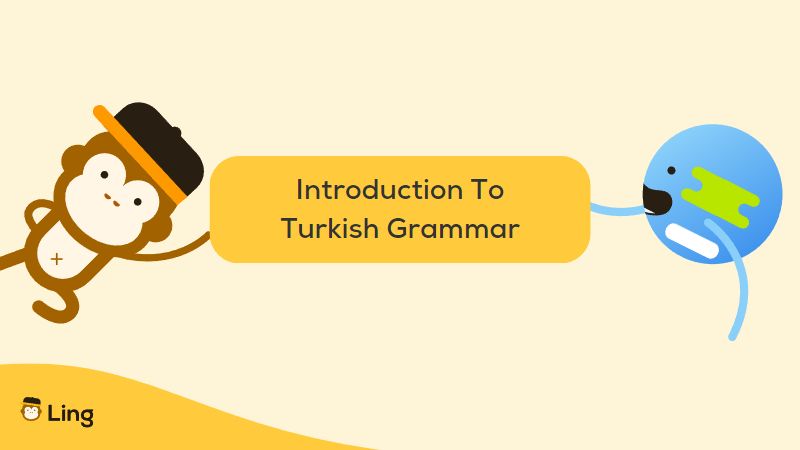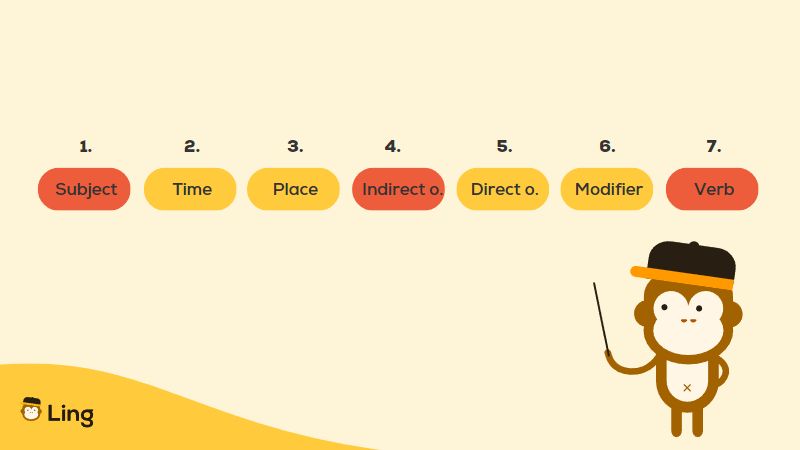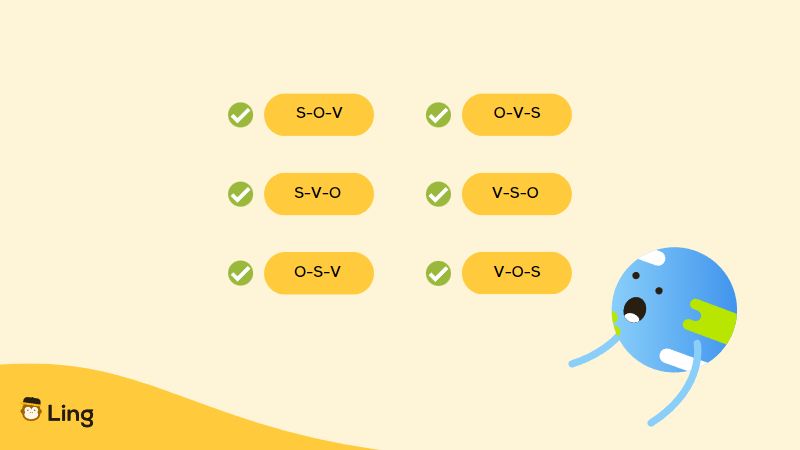We know that Turkish grammar looks intimidating but no worries; we’re here to help you. Let’s take a big step into Turkish grammar by learning the Turkish sentence structure today!
The most tedious part of learning a new language is probably grammar. I know no one who enjoys studying grammar even though they love the language itself and the Turkish language is no exception.
If you’ve already mastered the basic phrases in Turkish, it is time to start learning Turkish grammar. I’m afraid you can’t avoid it forever!
The best way to start studying Turkish grammar is to learn Turkish sentence structure, so in this blog post, we will focus on Turkish sentence structure. This is the first blog post about Turkish grammar, but stay tuned for the upcoming ones! Let’s get started with an introduction to Turkish grammar!
Page Contents:
- Is Turkish Grammar Easy?
- Is Turkish Grammar Similar To English?
- Introduction To Turkish Grammar
- How Many Tenses Are There In Turkish?
- Basic Turkish Sentence Structure
- Turkish Word Order In Regular Sentences
- Modifiers In Turkish Sentences
- How To Make Complex Sentences In Turkish?
- Learn Turkish With Ling!

Is Turkish Grammar Similar To English?
To be honest with you, the Turkish language and the English language have nothing in common. They come from different language families and since Turkish is not a European language, its grammar may be unfamiliar to you. The main difference between these two languages is the sentence structure. English has an S-V-O sentence structure whereas the S-O-V form is prominent in sentence structures in Turkish.
Is Turkish Grammar Easy?
The Turkish language may have the most logical grammar system that you haven’t seen in any other foreign language. Once you master the topics like vowel harmony, verb conjugation, and tense suffixes, Turkish becomes so easy to understand.
Now, you may be asking, is Turkish hard to learn? I answered that question in detail in a previous blog post. You may want to check it out!

Introduction To Turkish Grammar
Here are the must-know characteristics of the Turkish language regarding grammar:
✔ Nouns have no gender in Turkish.
✔ In Turkish, verbs generally come at the end of the sentence. Turkish adjectives and possessive nouns come before the noun they describe. Postpositions follow the noun they describe.
✔ Turkish is a highly agglutinative language meaning the words are composed of a sequence of morphemes meaning each suffix represents only a single grammatical category.
✔ Turkish suffixes help us to inflect a noun or verb according to plurality, person, tense, etc.
✔ Turkish has vowel harmony. Most suffixes have two or four different forms because when a suffix is attached to a verb stem, the vowel in the suffix has to agree in frontness or backness and in roundedness with the last vowel in the verb stem or of the preceding suffix.
✔ The suffix of Turkish perfect tense (-miş-, -müş-, -mış-, or -muş-) also has an inferential meaning. For example, gidiyormuşum has a meaning like ”they say that I am going”.
✔ Turkish verbs have six grammatical persons, five voices, and four main tenses. Meanings such as “not”, “can”, “should” and “if” are usually expressed with verbal suffixes in Turkish, unlike most European languages.
How Many Tenses Are There In Turkish?
There are five main tenses in Turkish with their suffixes:
| English Tense | Turkish Tense | Turkish Suffixes |
|---|---|---|
| Present continuous tense | Şimdiki zaman | -yor |
| Present simple tense | Geniş zaman | -r, -ar, -er |
| Definite past (seen) tense | Görülen geçmiş zaman | -dı, -di, -du, -dü |
| Indefinite past (heard/reported) tense | Duyulan geçmiş zaman | -mış, -miş, -muş, -müş |
| Future tense | Gelecek zaman | -ecek, -acak |
Basic Turkish Sentence Structure
The most essential thing that you must know is that Turkish sentence structure has an SOV (subject-object-verb) order. If you are an English speaker it may take some time to get used to it since English, as well as other European languages, has SVO (subject-verb-object) order.

Turkish Word Order In Regular Sentences
1. Subject
2. Time
3. Place
4. Indirect object
5. Direct object
6. Modifier of the verb
7. Verb
This is the order for a long complex sentence but it’s an S-O-V structure at its core. Remember that in a typical Turkish sentence, verbs are always placed at the end. Let’s check various regular sentences in the examples below!
Positive Sentences
- Yarın alışverişe gideceğim. – I will go shopping tomorrow.
- Okul bugün başladı. – The school started today.
- Bugün çok hastayım. – I am very sick today.
Negative Sentences
- Yarın alışverişe gitmeyeceğim. – I won’t go shopping tomorrow.
- Okul bugün başlamadı. – The school didn’t start today.
- Bugün hasta değilim. – I am not sick today.
Imperative Sentences
- Buraya gel! – Come here!
- Acele et! – Hurry up!
- Çeneni kapa! – Shut up!
Interrogative Sentences
There are two different types of interrogative sentences:
Question Words
In regular sentences, question words are usually placed at the beginning of the sentence. However, they can also come right before the verb. It doesn’t change the meaning at all but only the emphasis of the sentence changes.
- Ne zaman alışverişe gideceksin? – When will you go shopping?
- Hangi okula başladın? – Which school did you start?
- Neden hastalandın? – Why did you get sick?
- Nereye gideceksin? – Where will you go?
- Bugün ne yapacaksın? – What will you do today?
Yes-No Questions
To create a yes-no question, the sentence needs interrogative particles (-mı,-mi, -mu, -mü, or their conjugated forms). These interrogative particles are placed at the end of the sentence, right after the verb.
- Yarın alışverişe gidecek misin? – Will you go shopping tomorrow?
- Okul bugün başladı mı? – Did the school start today?
- Bugün hasta mısın? – Are you sick today?

Wrong Word Order In Turkish Is Totally Okay
Here are some examples of how Turkish language word order can vary:
Sev(mek) → (To) love
- S-O-V → Ben kızımı seviyorum. → I love my daughter.
- S-V-O → Ben seviyorum kızımı. → I love my daughter.
- O-S-V → Kızımı ben seviyorum. → I love my daughter.
- O-V-S → Kızımı seviyorum ben. → I love my daughter.
- V-S-O → Seviyorum ben kızımı. → I love my daughter.
- V-O-S → Seviyorum kızımı ben. → I love my daughter.
As you can see, I mixed the word order in the sentences above but they keep the same meaning. However, the emphasis is on different words indicated in orange text.
The emphasized word must be placed right before the verb in Turkish sentences. However, if there is nothing before the verb and it is placed at the beginning of the sentence, then the emphasis is on the verb itself. Just like the last two examples above.
Using only the S-O-V sentence pattern doesn’t necessarily mean that you speak Turkish fluently. A lot of native speakers mix up the word order when they speak in daily life. So feel free to use any sentence pattern you want!
Note: The S-O-V pattern is accepted as the regular sentence and the other patterns are named “inverted sentences” in Turkish.
Where To Use Inverted Sentences?
Inversion is used very often in Turkish. Changing the word, inversion is usually made for emphasis or rhyme. As a native speaker, I see a lot of inverted sentences in Turkish poetry and even in Turkish songs.
Inverted sentences are usually used in:
- Daily conversations
- Turkish literature
- Songs and proverbs (to make the words rhyme)
Modifiers In Turkish Sentences
Before moving forward with other Turkish sentence structure lessons, let’s make sure you know what a modifier is first. It’s a word, phrase, or clause that functions as an adjective or adverb. A modifier provides additional information or details about another word or word group to clarify a sentence.
A modifier can also be a group of words that gives more information about a noun or noun phrase to answer the “which” question. Other ones are groups of words that answer the “when, where, how, and why” questions.
A noun can be modified by another noun when placed right before it:
- Mutfak masası – Kitchen table
Nouns modified by present participles:
- Gülümseyen çocuk – Smiling kid
Nouns modified by past participles:
- Yanmış ekmek – Burnt bread

How To Make Complex Sentences In Turkish?
You can make complex and long sentences by using Turkish conjunctions but you can also do it by adding more information and detail to the sentence with the help of modifiers. Here is how I turned a simple sentence into a complex sentence in eight steps:
Want to learn Turkish from zero and speak fluent Turkish? Download the Ling app now and join thousands of other Turkish learners who learn the language in a fun and practical way! Read below for more information about our app!
Learn Turkish With The Ling App!
If you are thinking about learning Turkish or other languages, waste no more time and check out Ling to get started today!
Ling is a language learning app designed to help all language learners from beginning their language learning journeys. The app consists of various engaging activities, such as writing and listening exercises, quick quizzes, and an AI chatbot to practice your conversation skills. Ling offers you everything you’re looking for in a language-learning app.
Also, don’t forget to check out our Turkish blog for weekly articles related to the Turkish language and culture!
Trust me; you won’t regret it if you give Ling a try by simply downloading it from the App Store or Play Store.
Until next time! Görüşürüz!
Updated by: CJ


































































